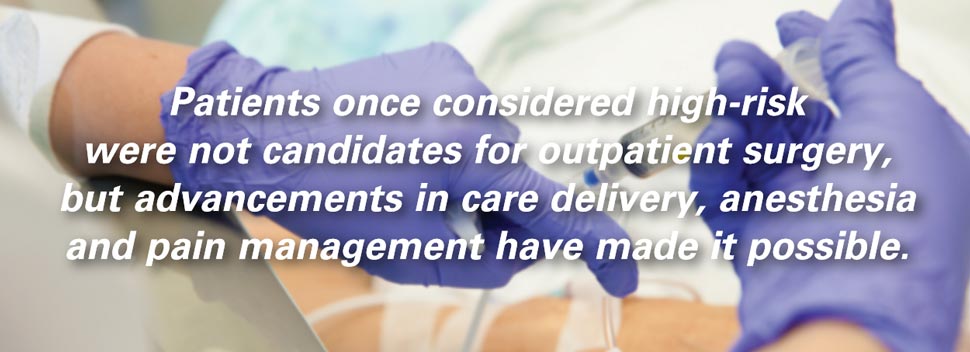- Home
- Article
Future Trends: From Vision to Vanguard: The Evolution of ASCs
By: Jeanine Watson, MSN, RN, CNOR(E), CASC | Clinical Editor
Published: 8/6/2025
Looking back on the past with an eye toward the future.
August is National ASC Month, and I want to take a moment to recognize the incredible professionals who work in this dynamic and demanding environment. You know who you are!
I truly cherished my time as an ASC leader. It shaped my career and taught me invaluable lessons. But let’s be honest: it required significant investments of time and energy and, yes, a fair share of sweat and tears.
To those delivering high-quality surgical care in outpatient settings: Thank you. You’re navigating complex challenges: shifting regulations, limited resources and rising expectations. Yet you remain resourceful, innovative and efficient.
Today’s ASC leaders are more than caregivers. They’re strategic business and clinical leaders who drive excellence in safety, quality and finance.
As we celebrate National ASC Month, allow me to reflect on the journey of ASCs from their bold beginnings to their current role as cornerstones of modern surgical care.
My personal journey with ASCs started in 1999, but their story began much earlier. In 1968, two visionary physicians in Phoenix sought to reduce the inefficiencies they found in hospital settings and improve the patient experience. They secured endorsements from government agencies and healthcare leaders, obtained financing and built the first ASC.
By 1970, the center opened its doors.
Start of a movement
Within months, 225 surgeons were practicing there and more than 40 insurers had signed up. It was a groundbreaking moment that set the stage for the rapid growth of outpatient surgical care.
In 1971, the American Medical Association endorsed the use of general and local anesthesia for select patients undergoing specific outpatient surgery procedures. At the time, patient selection criteria were likely very strict, reserved for those deemed low-risk.
Fast forward to today, and the shift is remarkable. Patients once considered high-risk were not candidates for outpatient surgery, but advancements in care delivery, anesthesia and pain management have made it possible.
By the end of the 1970s, ASCs had gained recognition from the American Society of Anesthesiologists, which issued guidelines for outpatient anesthesia. The number of ASCs reached triple digits, and national societies and accrediting agencies began to form, laying the groundwork for standardization and quality assurance.
The 1980s marked a period of rapid expansion. Medicare approved 200 ASC procedures in 1982, expanding to 1,535 by 1987. By 1988, there were 1,000 ASCs and a new Medicare payment system that is still in use today.
The 1990s brought further growth and important milestones. In 1994, Beth Derby became the first woman and the first nurse to be elected president of the Foundation for Ambulatory Surgery in America (FASA), a landmark moment for leadership diversity. In 1995, Medicare expanded its approved procedure list to more than 2,000, while ASCs gained global recognition with the formation of the International Association for Ambulatory Surgery.
In the 2000s, the ASC model continued to evolve. The Board of Ambulatory Surgery Certification introduced the Certified Ambulatory Surgery Center credential in 2002. By 2004, more than 4,000 U.S. ASCs were performing eight million surgeries annually. Medicare expanded its approved procedure list to more than 2,400. In 2006, the ASC Quality Collaboration was formed to develop standardized quality measures and publicly report data. In 2008, the American Association of Ambulatory Surgery Centers and FASA merged to form the Ambulatory Surgery Center Association, which continues to support ASCs through education, advocacy and resources.
By 2011, ASCs were performing 23 million surgeries annually, with more than 3,500 procedures approved by Medicare. In 2012, Medicare implemented its first ASC quality reporting program. The 21st Century Cures Act, passed in 2016, included provisions that improved care access for Medicare patients in ASCs. In 2019, CMS released a final rule that eased regulatory burdens related to hospital transfer agreements, medical history assessments and emergency preparedness.

Resilience in action
In 2020, Medicare approved total knee arthroplasty and six new cardiac procedures for ASCs — an important milestone in expanding the scope of outpatient surgical care. Today, ASCs routinely perform high-acuity procedures that once required hospital stays. CMS has proposed an additional 547 procedures for 2026.
While metrics and data points help illustrate the growth of the ASC industry, they don’t fully capture the collaboration, innovation and planning that made it possible.
As I reviewed this timeline, I couldn’t help but reflect on the broader challenges our nation faced during this period. Despite economic downturns, wars and even a global pandemic, ASCs have continued to grow and evolve. From the 1987 stock market crash to the Gulf War, the 1993 World Trade Center bombing, the tragic events of September 11, 2001, and the 2008 financial crisis, each moment tested our resilience. And, of course, the COVID-19 pandemic that began in 2020 reshaped health care in profound ways. These events parallel the challenges ASC leaders face today. Supply chain disruptions, staffing shortages and increasing regulatory demands may seem overwhelming, but I’m encouraged. ASC leaders have consistently demonstrated the ability to overcome obstacles and drive progress.
I have seen projections for market growth from $50 billion today to $75 billion by 2030. While I don’t have a crystal ball, I’m confident that the ASC industry will continue to meet challenges with the same innovation and collaboration that have defined its history. I’m excited to see what the future holds — and what this generation of ASC leaders will accomplish next.
Join AORN in celebrating ASC Month: visit aorn.us/celebrate-asc-2025 to take advantage of month-long perks and prizes! OSM
.svg?sfvrsn=be606e78_3)
.svg?sfvrsn=56b2f850_5)